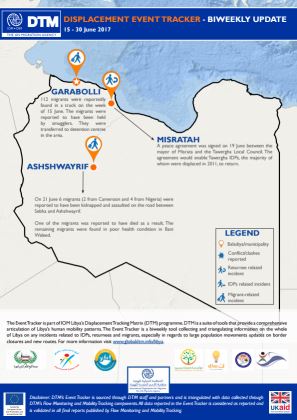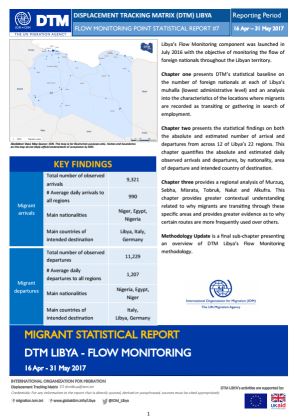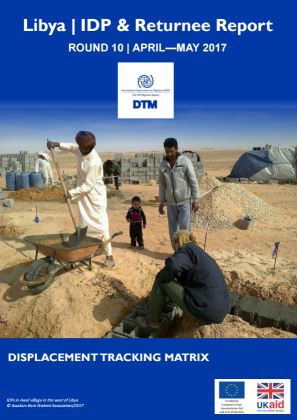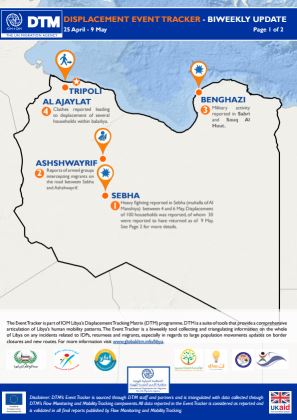-
Countries
-
Data and Analysis
-
Special Focus
-
Crisis Responses
Libya
Sobre Libya
Libya is a geographically vast country with several regions that are difficult to access. In order to understand the full scope of humanitarian assistance that is needed throughout the country, IOM established the Displacement Tracking Matrix (DTM) programme in 2016 in order to provide a common operating picture concerning the movement of populations in Libya, allowing humanitarian actors to provide timely assistance to those in need. Following the escalation of conflict and insecurity in 2014, the security situation has remained volatile since with fluctuations in the intensity of localized clashes. Congruently, conflict has caused new displacements, often in areas ill-equipped to accommodate large population movements while also negatively impacting the large migrant population residing and transiting through Libya. More recently, the capital Tripoli was heavily affected by displacement waves in September 2018 and April 2019.
DTM’s mobility tracking and flow monitoring activities identified many migrants in-country to be in need of various forms of assistance. Libya’s geographic location, resources and work opportunities has made it both a country of destination and transit for migrants for many years. Despite the deterioration of the security situation since 2011 migrants continue coming to and transiting through Libya, the majority from Sub-Saharan and North African countries.
In this complex operating environment, DTM Libya has been providing a common operating picture concerning the movement of populations in Libya since 2016, allowing humanitarian actors to provide timely assistance to those in need. Through its mobility tracking, flow monitoring and needs assessment activities, DTM Libya has established itself as data hub for quantitative data on migratory flows to and within Libya, migrant presence in Libya disaggregated by nationality and area, as well as humanitarian needs of migrants, internally displaced population and returnees. All activities are implemented through periodical bi-monthly data collection cycles, allowing trend analysis over time to provide evidence-base for both policy-level discussions and to guide humanitarian action.
In order to facilitate humanitarian interventions, DTM works closely with IOM’s other programmes through referring identified populations in need of assistance at flow monitoring points to IOM’s Direct Assistance, Health, Voluntary Humanitarian Return (VHR), Protection and Migrant Rapid Response Mechanism (MRRM) programmes. Furthermore, DTM Libya supports other humanitarian partners through providing emergency tracking updates in case of sudden population movements as well as facilitating humanitarian assessments for the Rapid Response Mechanism (RRM) jointly implemented by IOM, UNICEF, WFP and UNFPA.
For more information on IOM's activities in Libya, please visit the IOM Libya country office website.
Contacto
DTM Libya
DTMLibya@iom.int
Current Donors
- EUTF
Para obtener resultados de búsqueda más avanzados, vaya a la Página de búsqueda avanzada de informes
Libya — IDP and Returnee Report 11 (May—June 2017)
From May to June 2017 DTM Libya interviewed 1,198 key informants across 100 Baladiyas and 657 Muhallas. A total of 226,164 IDPs were identified.
Libya — IDP and Returnee Key Findings Report 11 (May —June 2017)
From May to June 2017 DTM Libya interviewed 1,198 key informants across 100 Baladiyas and 657 Muhallas. A total of 226,164 IDPs were identified. The threat of violence from conflict and the presence of armed groups was the main driver of displacement for 93% of the displaced population.
Libya — IDP and Returnee Key Findings Report 12 (June — July 2017)
In July and August 2017 DTM Libya interviewed 1,301 key informants across 100 Baladiyas and 657 Muhallas. A total of 217,022 IDPs were identified.
Libya — Maritime Incidents Update (6—20 July 2017)
During the period of 6 and 20 July, 456 individuals were rescued and 2 bodies were retrieved from the Libyan coast. As of 20 July, 11,122 individuals have been rescued in 2017.
Libya — Displacement Event Tracking Report (1–18 July)
In Garabolli, clashes on 9 July led to the displacement of approximately 250 households to multiple baladiyas including Tajoura, Tarhuna, Qasr Akhyar and Bani Waleed. As of 10 July, 75,000 individuals were reported to have returned to Sirt.
Libya — Migrant Report 10 (April — May 2017)
During this round of data collection DTM identified 393,652 migrants across 494 Muhallas and 100 Baladiyas. 20% of the migrant population was identified in Misrata, 15% in Tripoli and 11% in Almargeb, these represent the locations at which the most migrants were identified in this round.
Jul 12 2017
Libya — Migrant Report 10 (April — May 2017)
Libya — Maritime Incidents Update (22 June — 5 July 2017)
During the reporting period 632 people were rescued and 44 bodies were retrieved. 10,666 individuals have been rescued thus far in 2017.
Libya — Displacement Event Tracking Report (15—30 June 2017)
In Garabolli, 112 migrants were reportedly found in a truck on the week of 15 June 2017 and six migrants were reported to have been kidnapped and assaulted on the road between Sebha and Ashshwayrif.
Libya — Flow Monitoring Statistical Report 7 (16 April — 31 May 2017)
During the reporting period DTM Libya observed 9,321 arrivals and 11,229 departures. Amongst both the arriving and departing populations the main nationalities were Egyptians, Nigerians and Nigeriens.
Libya — Maritime Incidents Update (8 — 21 June 2017)
From 8-21 June 2017 1,741 people were rescued and 67 bodies were retrieved. Thus far in 2017 10,034 have been rescued.
Libya — IDP and Returnee Report 10 (2 April—4 May 2017)
From April to May 2017 DTM Libya interviewed 914 key informants across 100 Baladiyas and 657 Muhallas. A total of 240,188 IDPs were identified.
Libya — IDP and Returnee Key Findings Report 10 (2 April—4 May 2017)
From April to May 2017 DTM Libya interviewed 914 key informants across 100 Baladiyas and 657 Muhallas. A total of 240,188 IDPs were identified.
Libya — Displacement Event Tracking Report (1—14 June 2017)
In Sabratha, clashes between the Libyan Coast Guard and migrant smugglers were reported on 11 of June, which led to the death of one migrant and the injury of two others. In Azzawaya, Conflict between two families in Azzawya on 3 June led to the death of 8 people and the injury of 17.
Migrant Report Key Findings 10 (May 2017)
In Round 10 DTM Libya’s Mobility Tracking identified 393,652 migrants. Migrants were identified in all 100 baladiyas and 494 muhallas. 9% of migrants are minors.
Jun 13 2017
Migrant Report Key Findings 10 (May 2017)
Libya – Maritime Incidents Update (25 May – 7 June 2017)
During the reporting period 1, 944 people were rescued and eight bodies were retrieved.
Libya — Displacement Event Tracking Report (17—31 May 2017)
An outbreak of armed conflict in Abusliem was reported on 26 May leading to the displacement of several families. Damage was also sustained by several residences. 15 households were reportedly displaced from Abusliem to Tarhuna.
Libya — IDP and Returnee Report 9 (March 2017)
DTM identified 265,615 IDPs and 227,866 returnees in Libya in March 2017. This represents a decrease of IDPs and increase in returnees from the previous round, mainly due to the return of a large number of IDPs to Sirte during the time of data collection.
May 26 2017
Libya — IDP and Returnee Report 9 (March 2017)
Libya — Migrant Report 9 (March—April 2017)
351,382 migrants were identified during this round of reporting. 466 of 677 Muhallas and 100 (all) Baladiyas were assessed. 90% of the identified migrants were adults and 10% were minors.
May 26 2017
Libya — Migrant Report 9 (March—April 2017)
Libya - Maritime Incidents Update (12 - 24 May 2017)
During the reporting period 1,005 people were rescued and 10 bodies were retrieved.
Libya — Maritime Incidents Update (28 April – 11 May 2017)
During the reporting period, IOM recorded 510 persons rescued (5—7 April) and one body retrieved (2 May) in Zuwara. In Az Zawiyah, IOM recorded 7 rescued individuals (7 May) and 11 retrieved bodies (8 May). In Tripoli, IOM registered 665 rescued persons (6—10 May).
Libya — Maritime Incidents Update (28 April – 11 May 2017)
During the reporting period, IOM recorded 510 persons rescued (5 and 7 April) and one body retrieved (2 May) in Zuwara. In Az Zawiyah, IOM recorded 7 rescued individuals (7 May) and 11 retrieved bodies (8 May). In Tripoli, IOM registered 665 rescued persons (6 and 10 May).
Libya — Flow Monitoring Statistical Report 6 (16 February — 15 April 2017)
Flow Monitoring Statistical Reports present data on migrant flows in Libya. Data is gathered at key points where migrants gather and transit in Libya. This report presents the results of 819 assessments conducted in the reporting period from 16 February to 15 April 2017.
Libya — Displacement Event Tracking Report (25 April — 9 May 2017)
Displacement events were recorded in Tripoli, Al Ajaylat, Benghazi, Ashshwayrif and Sebha.
Libya — Rapid Assessment: Displacement from Tamnhnt, Albawanees (2 May 2017)
Clashes around Tamnhnt airport base began in early April 2017 and have been ongoing until the time of publication. DTM conducted a rapid assessment in the affected areas to determine the impact of the clashes on populations residing in the area.
Pagination
Para obtener resultados de búsqueda más avanzados, vaya a la Página de búsqueda avanzada de conjuntos de datos
Pagination
- First page
- Previous page
- 1
- 2
- 3
- 4
- 5


























